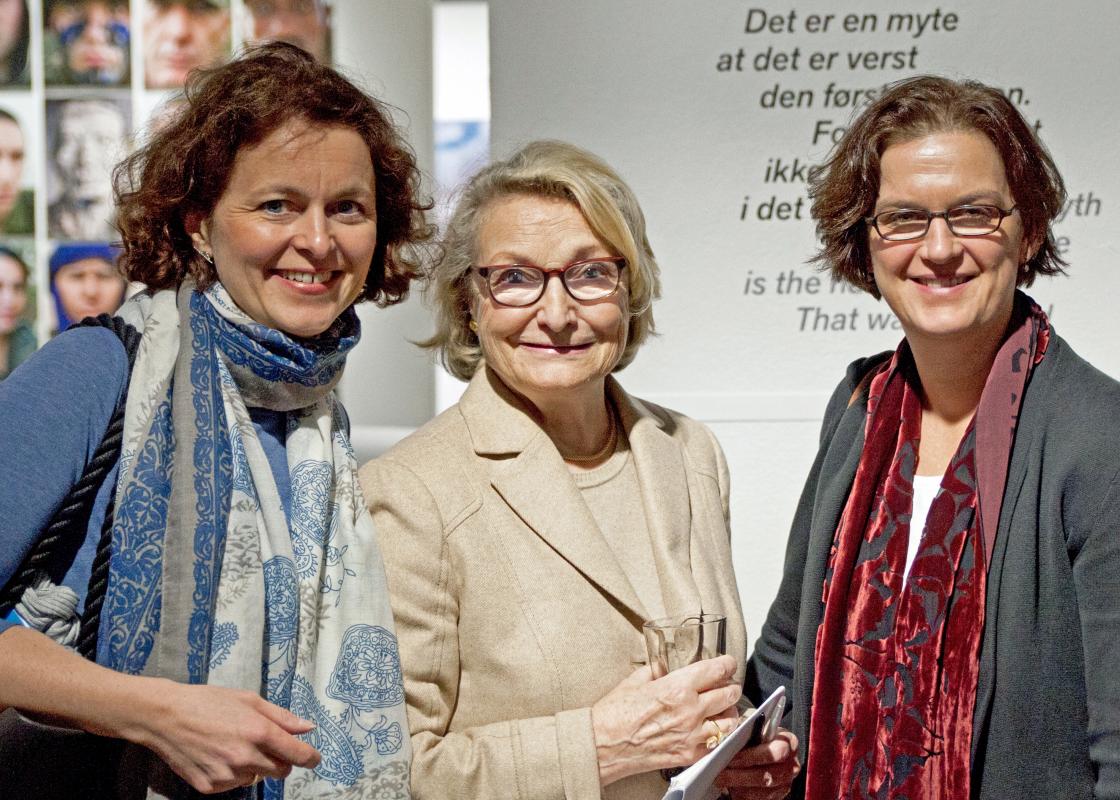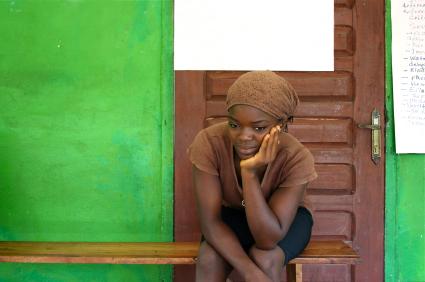On the global agenda, war and peace was primarily something that pertained to men, at least up until 1995, when the United Nations’s fourth women’s conference in Beijing addressed the integration of gender equality issues in all aspects of politics and planning. Twelve areas in need of measures were described, one of them being “Women and armed conflict”. Women should participate in peace negotiations, was one of the conclusions. Women living in conflict situations are to be protected.
“A seed was sown in Beijing,” says Inger Skjelsbæk.
The same year as the women’s conference took place, she started as a graduate student of psychology at the Peace Research Institute Oslo (PRIO). The institute was established in 1959 by Ingrid Eide and Mari Holmboe Ruge among others, researchers with strong ties to the women and peace movement. But since then the gender perspectives had disappeared from PRIO, according to Skjelsbæk.
The psychology student was interested in how gender is constructed, and wondered:
“Is there a difference between men and women when it comes to war and peace? Are women more peaceful?”
Skjelsbæk does not think there are intrinsic differences making women more peaceful than men; she thinks the essential factor is that men and women bring different experiences into e.g. peace processes.
The essential factor is that men and women bring different experiences into peace processes.
The topic for her thesis became women and experiences of war, and when she had completed her thesis, the Ministry of Foreign Affairs contacted PRIO with a desire to initiate research on gender and conflict. Skjelsbæk became a natural part of this work, her first contribution being gender perspectives training within the UN system. And the institute kept following up. Skjelsbæk got funding for a PhD on women’s experiences after the Balkan wars. She got a lot of support from the leadership at PRIO: a gender perspective on war and conflict was something they wanted to pay attention to. But she was not convinced herself.
“This was so marginal in the late 1990s. Studying this felt a bit like committing academic suicide.”
The feeling of loneliness on the field of gender and war/peace also had practical consequences for Skjelsbæk.
“Every e-mail, letter, report – anything that had to do with women – ended up in my mailbox.”
The snowball effect
At the end of the 1990s, she met Torunn L. Tryggestad, who was working as a researcher at the Norwegian Institute of International Affairs (NUPI) at the time. They realised that they shared the same interest in gender perspectives in armed conflicts.
“I became more and more interested in the topic, but I was working on completely different things and had problems getting institutional support for the fact that this was an interesting direction to go,” says Tryggestad.
The two of them decided to apply for funding for a series of seminars from the Research Council. The application was granted, and in 1998, Skjelsbæk and Tryggestad invited international scholars on the field to participate in discussions on topics related to women and peace. The snowball had started rolling.
In 2000, The United Nations Security Council passed resolution 1325 on women, peace, and security. Here it was established that women should participate in peace processes, that sexual violence should be stopped, assailants should be prosecuted, and that the UN’s peacekeeping work should include gender perspectives.
For the first time in UN’s history, the Security Council took a stand on issues related to women’s role and experiences in armed conflict.
In Norway, the resolution was quickly followed up by supporting the UN’s work, but the government also began thinking about initiating its own measures.
At PRIO, the leadership finally saw their chance to strengthen the gender competence at the institute. Helga Hernes, political scientist, women's studies scholar, politician, and diplomat, had recently retired from her position in the diplomatic service when Skjelsbæk contacted her in 2005 and asked her to come work at PRIO.
For the first time in UN’s history, the Security Council took a stand on issues related to women’s role and experiences in armed conflict.
Tryggestad was also lured over from NUPI, and together with Hernes, she set to work on a new task: The Ministry of Foreign Affairs wanted an action plan on Women, Peace and Security. And they wanted it fast.

From December 2005 until the launch on 8 March 2006, Tryggestad gathered threads and experiences for the written material whereas Hernes pulled a few strings at the authorities with the help of the Ministry of Foreign Affairs’ own capacity who handled comments and suggestions from the Ministry.
“I went to the Minster of Defence, I went to the Minister of Justice… I could do these things because I’d been a diplomat and a state secretary,” says Hernes.
Thus, the contributions came quickly and the world’s first action plan on the topic became a success.
“I think we succeeded well! Both Sweden and the United Kingdom called us on the phone, the Netherlands… suddenly there was huge interest,” says Hernes.
See also: UN resolution 1325 ten years on
See also: Using the body as a weapon
Knocked on doors
Internally at PRIO, the trio popularly referred to as the Gender group challenged their colleagues.
“We picked out researchers whom we thought had interesting projects and knocked on their doors and asked: If you were to apply a gender perspective on what you’re currently working with, what would it be?” says Skjelsbæk.
Significant scholars such as Henrik Syse took the challenge offhand and gave a lecture on gender and ethics.
Wenche Iren Hauge investigated demobilising of soldiers in Guatemala. She went back there and specifically interviewed female soldiers. It provided new perspectives entirely.
By including gender perspectives in research on mines, researcher Hilde Wallacher demonstrated how women might be of particular help during mine search, since they move across larger areas than men in their daily work.
And demining teams consisting only of women work better than teams only consisting of men. All-women teams have almost no accidents, they are more careful. Employing women for this type of work also has major consequences for the local communities, since women to a larger extent than men put money back into the local communities.
Demystifying gender
“Researchers as well as others tend to get a little stuck and do things the same way they always have. When discussing with others you get new ideas,” says Tryggestad.

“These were people working with relevant issues such as health in Africa. It was easy for them to see that these perspectives were relevant,” Hernes continues.
According to Tryggestad, many were surprised that they hadn’t thought about the gender perspectives before, as they often seem so obvious when you become aware of them.
“I’ve also thought about that a lot – why isn’t there more research on this? It is so obvious! It is relevant, and you obtain new knowledge by seeking women’s experiences.”
Skjelsbæk wants to demystify gender perspectives.
“Many people are afraid of not being politically correct when talking about gender, particularly in a global perspective. Thus it’s important to make it practical, not dogmatic.”
She says it has been useful to work with this topic within the institute sector.
“In the institute sector you have to make everything tangible. We’re theoretically heavy, but we work towards both academia and clients. We meet the user of the knowledge we generate in various contexts, which is very instructive.”
Interested in gender perspectives? Sign up for our newsletter!
Tired of applications
At the same time, the sector has its challenges. Despite the success with the action plan, the Gender group at PRIO had no long-term funding. There were no major funding programmes into which their research fitted. They had to apply for new funding every year, which was frustrating, according to Tryggestad.
“We’ve spent a lot of time writing grant applications. Even though we couldn’t know, for my own part, I’ve just reckoned that it would be long-term.”
“Many people are afraid of not being politically correct when talking about gender, particularly in a global perspective.”
And the funding kept coming in, although Tryggestad still remembers a phone conversation with the programme coordinator at the Research Council where she presented a desire to apply for funding from the gender research programme.
“We were told 'yes, we’re open for all types of applications, but I advise you to read the programme description'. What was said between the lines, I think, was that there was no point in applying.”
According to Skjelsbæk, there was little room for global perspectives on gender in the Research Council’s portfolio.
“I find it strange that there haven’t been any long-term funding mechanisms promoting global challenges on gender equality. The Ministry of Foreign Affairs probably hasn’t provided sufficient pressure and funding, and at the same time, many of the gender and women research communities have become very Nordic or Norwegian. We’ve been a bit homeless. But I think that is about to change.”
To Skjelsbæk this uncertainty is the reason why she’s now working at the Department of Psychology at the University of Oslo and not at PRIO.
“You get so tired of having to apply for funding every year. It’s a structural problem.”
See also: When feminism legitimizes war
Dangerous involvement
In 2015, PRIO’s Gender group was finally granted a large pot of money, with project funding for four years (FRIPRO). The institute now has eight major projects in which gender perspectives are central. And on a global scale, the interest in these issues has exploded, according to Tryggestad. This is particularly the case with the topic that Skjelsbæk started working on nearly twenty years ago: sexualised violence in armed conflicts.
Tryggestad herself recently gave a course for UN’s peace negotiators in an attempt to make them bring the 1325 resolution out in the field. But there is still a long way to go. Many women still contribute to political processes at the risk of their own lives.
“There are a lot of threats and violence against women who are actively involved in politics.”
“There are a lot of threats and violence against women who are actively involved in politics. There has been a lot of focus on helping women who have been victims of violence or rape, and there has been much focus on the empowerment of women. But we need to look at the strong links here in order to move a step further,” says Tryggestad.
“Unless women’s position in society and the respect for women is strengthened, we won’t be able to prevent violence against women. Unless we combat violence against women we won’t succeed in empowering women and activate them politically.”
The 1325 resolution was passed by the United Nation’s Security Council 31 October 2000. The resolution’s overriding objective is to increase women’s involvement and influence in the work to prevent, handle, and solve conflicts. The resolution shall also contribute to the protection of women’s rights during migration, war, and conflict, and integrate gender perspectives in work on peace building.



